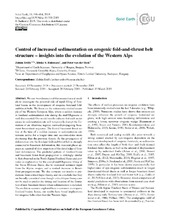| dc.contributor.author | Erdös, Zoltan | |
| dc.contributor.author | Huismans, Ritske | |
| dc.contributor.author | van der Beek, Peter | |
| dc.date.accessioned | 2020-04-03T09:35:36Z | |
| dc.date.available | 2020-04-03T09:35:36Z | |
| dc.date.issued | 2019-03-13 | |
| dc.Published | Erdös Z, Huismans RS, van der Beek P. Control of increased sedimentation on orogenic fold-and-thrust belt structure-insights into the evolution of the Western Alps. Solid Earth (SE). 2019;10(2):391-404 | eng |
| dc.identifier.issn | 1869-9510 | en_US |
| dc.identifier.issn | 1869-9529 | en_US |
| dc.identifier.uri | https://hdl.handle.net/1956/21679 | |
| dc.description.abstract | We use two-dimensional thermomechanical models to investigate the potential role of rapid filling of foreland basins in the development of orogenic foreland fold-and-thrust belts. We focus on the extensively studied example of the Western European Alps, where a sudden increase in foreland sedimentation rate during the mid-Oligocene is well documented. Our model results indicate that such an increase in sedimentation rate will temporarily disrupt the formation of an otherwise regular, outward-propagating basement thrust-sheet sequence. The frontal basement thrust active at the time of a sudden increase in sedimentation rate remains active for a longer time and accommodates more shortening than the previous thrusts. As the propagation of deformation into the foreland fold-and-thrust belt is strongly connected to basement deformation, this transient phase appears as a period of slow migration of the distal edge of foreland deformation. The predicted pattern of foreland-basin and basement thrust-front propagation is strikingly similar to that observed in the North Alpine Foreland Basin and provides an explanation for the coeval mid-Oligocene filling of the Swiss Molasse Basin, due to increased sediment input from the Alpine orogen, and a marked decrease in thrust-front propagation rate. We also compare our results to predictions from critical-taper theory, and we conclude that they are broadly consistent even though critical-taper theory cannot be used to predict the timing and location of the formation of new basement thrusts when sedimentation is included. The evolution scenario explored here is common in orogenic foreland basins; hence, our results have broad implications for orogenic belts other than the Western Alps. | en_US |
| dc.language.iso | eng | eng |
| dc.publisher | Copernicus | en_US |
| dc.rights | Attribution CC BY | eng |
| dc.rights.uri | https://creativecommons.org/licenses/by/4.0/ | eng |
| dc.title | Control of increased sedimentation on orogenic fold-and-thrust belt structure-insights into the evolution of the Western Alps | en_US |
| dc.type | Peer reviewed | |
| dc.type | Journal article | |
| dc.date.updated | 2020-02-18T11:43:39Z | |
| dc.description.version | publishedVersion | en_US |
| dc.rights.holder | Copyright Author(s) 2019 | en_US |
| dc.identifier.doi | https://doi.org/10.5194/se-10-391-2019 | |
| dc.identifier.cristin | 1705769 | |
| dc.source.journal | Solid Earth (SE) | |

